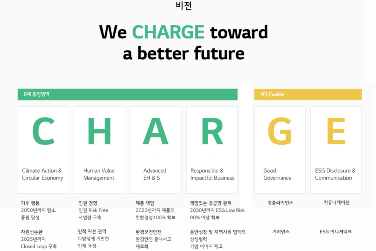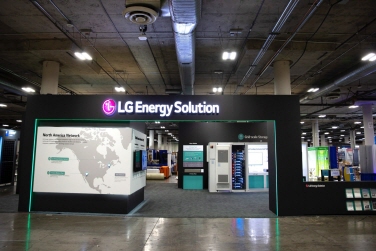- LGES posts quarterly revenue of KRW 8.774 trillion, operating profit of KRW 461 billion in the second quarter of 2023
- The company records strong first half-year performance by strengthening competitiveness amid growing EV demands in the U.S. market
- LGES aims for over mid-30 percent annual revenue growth despite market uncertainties, with solid product competitiveness and diverse customer portfolio
Conference Call
Earnings Presentation
SEOUL, July 27, 2023 – LG Energy Solution (LGES; KRX: 373220) today announced its second quarter earnings, posting steady quarterly revenue growth, as well as strong performance in the first half-year.
Despite potential impact of market uncertainties surrounding the EV / battery sectors, the company also revised its 2023 growth target to mid-30 percent increase year-on-year in annual revenue, which is up from the previous target of 25 to 30 percent growth announced in January.
LGES posted consolidated revenue of KRW 8.774 trillion for 2Q, marking a 0.3 percent increase from its highest quarterly record reported in the first quarter, and a 73 percent increase year-on-year. “Increased shipments to North America thanks to its robust EV market led the revenue growth this quarter,” explained Chang Sil Lee, CFO of LG Energy Solution, “even if demands in Europe relatively declined, and the average selling price (ASP) decreased due to falling metal prices.”
The company’s second quarter operating profit recorded at KRW 461 billion, a 27 percent decrease quarter-on-quarter and a 136 percent increase year-on-year. The figure, which includes the estimated IRA tax credit amount of KRW 110.9 billion, is about KRW 150 billion lower than the company’s preliminary earnings number announced earlier this month. This was due to one-off provisioning of KRW 151 billion caused by inflated costs of material expenses for the ongoing Chevrolet Bolt EV recall process.
“In addition to the one-off cost related to the recall, the increased costs of metal expenses from lagging consumption of raw material inventories also affected our bottom line,” said Chang Sil Lee. “However, we consistently improved productivity, as well as cost-efficiency for business operations including logistics, and accordingly, when the one-off factor is excluded, the operating profit margin saw a significant improvement year-on-year.”
■ Strong First Half-Year Performance Upon Increasing Global EV Demand
LGES also shared its first half-year performance, highlighting its strong financial results based on the increasing global EV demand, mainly led by the U.S. market growth.
According to SNE Research, global EV sales[1] from January to May this year increased by 43 percent from the same period last year, reaching 4.85 million vehicles. Particularly, U.S. EV sales have shown the highest year-on-year growth of 54.1 percent, rolling out 560,000 EVs.
By enhancing its production network, customer portfolio, and supply chain in the U.S., as well as capitalizing on the favorable market environment, LGES’s first half-year revenue amounted to KRW 17.5 trillion, an 86 percent increase year-on-year. Such accomplishment was possible thanks to the steady ramp-up at GM JV (Ultium Cells) plant in Ohio and the increase in sales of EV cylindrical batteries.
In the same period, the company has also successfully reinforced its profitability through yield and cost innovation, and diversifying its supply chains by investing in upstream suppliers and securing long-term purchase agreements. As a result, LGES recorded the operating profit of KRW 1.1 trillion[2], marking a 140 percent increase from the previous year, and the order backlog of KRW 440 trillion in the first half of 2023.
■ Aiming for over Mid-30 Percent Annual Revenue Growth
Continuing on from its first half-year achievements, LGES now aims to secure sustainable market competitiveness and industry leadership amid the expected declines in EV demands and metal pricing.
Global EV demand forecasts were adjusted downwards in all markets except for the U.S. While the U.S. EV market will continue to grow, demands in Europe and China are expected to be lower than previous estimate. Also, metal prices including lithium are down over 50% from its peak this year, which is expected to be reflected into the average selling prices mainly from the second-half.
To counter these external uncertainties, LGES will focus on its mid- to long-term strategic initiatives geared toward securing persisting competitiveness in products, operation, and sourcing.
- Products: LGES will develop and manufacture customized products by each target market. The company plans to set up 4680 cylindrical production lines at its plant in Ochang, Korea, and convert some of the ESS lines to LFP (Lithium Iron Phosphate) at the Nanjing plant in China within the year. LGES will also enhance product competitiveness by market segment, including high voltage mid-nickel (Mid-Ni), manganese-rich, and LFP batteries.
- Operation: LGES plans to expand its global production capacity by executing smooth capacity expansion of new projects such as the U.S. joint venture plant with Hyundai Motor Company. LGES will also pursue early global operation stability by accelerating smart factory adoption.
- Sourcing: LGES will strengthen its global supply chain by securing stable supply of cost-competitive critical minerals and raw materials, as well as seeking to expand local supply chains. Systematic preparation for recycling businesses will also take place, particularly by establishing closed-loop system at each production facility, thereby securing leading market presence for the battery recycling and reuse market.
Based on LGES’s product competitiveness and diverse customer portfolio, along with the mid- to long-term projection that EV market will quintuple by 2030, LGES’s full year revenue for 2023 is expected to grow over mid-30 percent year-on-year with continuous improvement in profit margin.
“Despite some uncertainties expected in the second-half, we’re well positioned to ride out such challenges, as we have already secured solid customer base and product portfolio through our long devotions to product competitiveness and operational expertise,” said Youngsoo Kwon, CEO of LG Energy Solution. “We will continue on with our great performance in the first half-year and further reinforce our profitability, thereby leading the global trend of electrification with our world-best quality products.”
[1] EV: including battery electric vehicles (BEV) and plug-in hybrid electric vehicles (PHEV)
[2] The first half-year operating profit includes the estimated IRA tax credit of KRW 211 billion.





